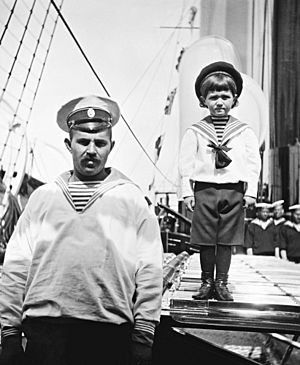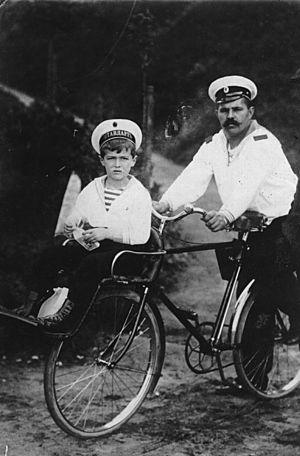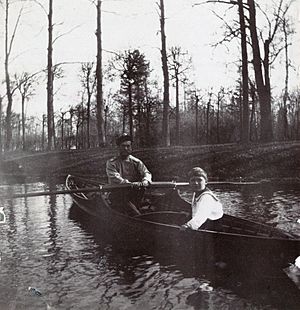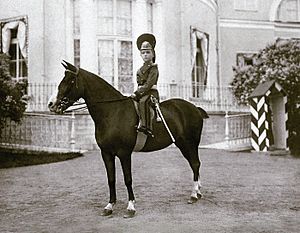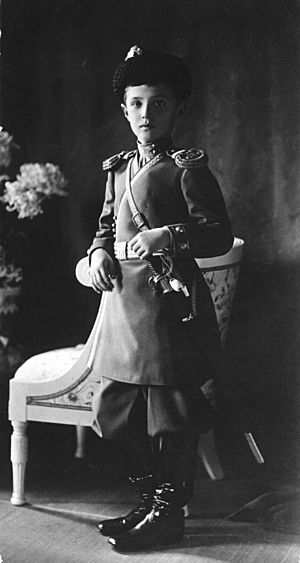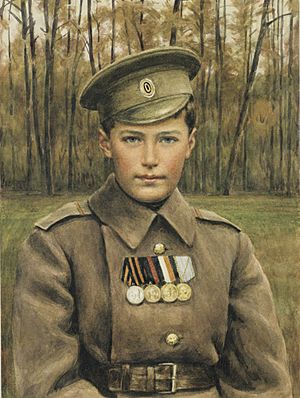Alexei Nikolaevich, Tsarevich of Russia facts for kids
Quick facts for kids Alexei Nikolaevich |
|||||
|---|---|---|---|---|---|
| Tsesarevich of Russia | |||||
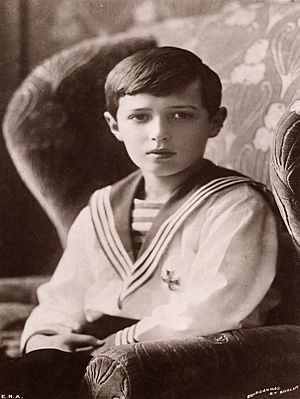
Alexei in 1913
|
|||||
| Born | 12 August 1904 [O.S 30 July] Peterhof Palace, St. Petersburg Governorate, Russian Empire |
||||
| Died | 17 July 1918 (aged 13) Ipatiev House, Yekaterinburg, Russian Soviet Republic |
||||
|
|||||
| House | Holstein-Gottorp-Romanov | ||||
| Father | Nicholas II of Russia | ||||
| Mother | Alix of Hesse and by Rhine | ||||
| Religion | Russian Orthodox | ||||
| Signature |  |
||||
Alexei Nikolaevich (Russian: Алексе́й Никола́евич) was the last Tsesarevich of Russia. This means he was the heir apparent to the throne of the Russian Empire. He was born on August 12, 1904, and died on July 17, 1918.
Alexei was the youngest child and only son of Emperor Nicholas II and Empress Alexandra Feodorovna. He was born with a serious blood condition called haemophilia. His parents tried to treat it using a peasant faith healer named Grigori Rasputin.
After the February Revolution in 1917, Alexei and his family were sent away to Tobolsk, Siberia. Later, after the October Revolution, the family was moved to Yekaterinburg. Because of the Russian Civil War, the Soviet government decided to execute them. On July 17, 1918, Alexei, his family, and four helpers were killed. For many years, people thought Alexei might have escaped. But his remains were found in 2007, along with those of his sister Maria (or Anastasia). In 1998, his parents and three sisters were buried. In 2000, the Russian Orthodox Church recognized Alexei and his family as saints.
Contents
Alexei's Look and Character
Alexei was a very handsome boy. He looked a lot like his mother. His teacher, Pierre Gilliard, said that Alexei was "one of the handsomest babies one could imagine." He had lovely fair curls and big blue-grey eyes. Later, Gilliard described him as tall for his age, with a "finely chiseled face" and "auburn hair with a coppery glint."
Alexei was proud to be the Tsarevich. He enjoyed being kissed on the hand by officers. He also liked to boast about it to his sisters. He loved watching the guards salute him. His father, Nicholas, once joked that Alexei was "Alexei the Terrible" because he was so strong-willed.
Alexei loved going to army inspections with his father. When he was three, he wore a tiny army uniform and played with a toy rifle. He even had his own Cossack uniform with a fur hat and a dagger. He wanted to be a warrior-tsar and lead armies.
Because of his hemophilia, Alexei was not allowed to do many things other boys could. He couldn't ride a bike or play tennis. He once asked angrily, "Why can other boys have everything and I nothing?" His sisters were good at horse riding, but he was forbidden from it.
Alexei didn't have many friends his age and was often lonely. His mother worried he might get hurt if he played with his cousins. His closest friends were the two young sons of his sailor-nanny, Derevenko.
Despite his illness, Alexei was adventurous. He was restless and couldn't stay still for long. When he was seven, he stole a bicycle and rode it around the palace. His father ordered the guards to catch him! Nicholas eventually decided to let Alexei do more things, as long as it wasn't too dangerous.
Alexei could be disobedient. His older sister Olga found him hard to control. But he always obeyed his father. Once, he threw a lady's parasol into a river. His father scolded him, and Alexei quickly apologized.
As a young child, Alexei sometimes played pranks. At a dinner party, he took a guest's shoe from under the table. He showed it to his father, who told him to return it. Alexei put a big strawberry in the shoe before giving it back!
As he grew older, Alexei became more thoughtful. When he was nine, he asked his friend Gleb to draw pictures for his favorite jingles. He wrote a note but crossed out his signature. He explained that if his signature was there, it would be an order, and he only meant it as a request.
Alexei enjoyed playing the balalaika, a Russian musical instrument. His favorite pet was a spaniel dog named Joy. He also had an old performing donkey named Vanka. Alexei would give Vanka sugar cubes, and Vanka would pull him in a sled during winter.
His teacher, Gilliard, said that Alexei was a simple and loving child. But servants and others at court often spoiled him. Once, peasants came to give Alexei gifts. Derevenko made them kneel, which embarrassed Alexei. He told Gilliard he didn't like it but "dare not" stop Derevenko.
Gilliard wrote that Alexei was "the center of this united family." His sisters loved him, and he was his parents' joy. When he was well, the palace felt much brighter. Gilliard helped Alexei's parents understand that giving him more freedom would help him grow. Alexei became more self-controlled. People noticed that his illness made him more understanding of others' pain.
Alexei knew he might not live to be an adult because of his disease. When he was ten, his sister Olga found him looking at the clouds. He told her, "I enjoy the sun and the beauty of summer as long as I can. Who knows whether one of these days I shall not be prevented from doing it?"
Early Life
Alexei was born on August 12, 1904, at Peterhof Palace in the Russian Empire. He was the youngest of five children. His older sisters were Grand Duchesses Olga, Tatiana, Maria, and Anastasia.
His birth brought great joy because he was the first son after four daughters. His mother, Alexandra, was so happy she couldn't believe it was true. His father, Nicholas, wrote in his diary that it was a "great and unforgettable day." People in St. Petersburg celebrated with flags and church bells. Nicholas even offered political forgiveness to prisoners and started a fund for military scholarships.
Nicholas named Alexei after Alexis of Russia, one of his favorite emperors. His family lovingly called him "Baby" or "Alyosha." From birth, he was given the title of tsarevich, meaning he was the heir to the Russian throne.
Alexei was christened on September 3, 1904, at Peterhof Palace. His godparents included his grandmother and his great-uncle. His oldest sister, Olga, was also a godparent. Even all active soldiers and officers of the Russian Army and Navy were named honorary godfathers.
Alexei's Hemophilia
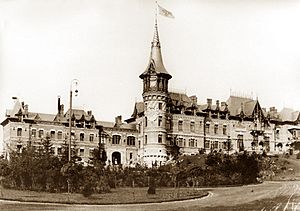
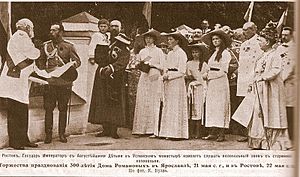
Alexei inherited hemophilia from his mother, Alexandra. This is a genetic condition where blood does not clot properly. It was known as the "Royal Disease" because many European royal families, who often married each other, had it. In 2009, tests showed Alexei had hemophilia B.
At first, Alexei seemed like a healthy baby. But after his umbilical cord was cut, his navel bled for hours. His blood would not clot. His parents were very worried.
Nicholas and Alexandra decided to keep Alexei's illness a secret from the public and even from family members. Alexandra wrote about the "anguish" of hiding his pain. Because of this secrecy, there were many rumors about his health.
When Alexei was five, two navy sailors, Andrei Derevenko and Klementy Nagorny, were assigned to watch him constantly. They made sure he didn't injure himself. Anna Vyrubova, a friend of Alexandra, said Derevenko was very patient and helped Alexei with his pain for hours.
Even small injuries, like a bruise or a nosebleed, could be life-threatening for Alexei. His parents were always worried. His frequent illnesses also made it hard for him to have a normal childhood and education.
Nicholas and Alexandra believed that Grigori Rasputin, a peasant monk, had special powers to heal Alexei. They kept his visits secret.
In 1907, Alexei fell and hurt his leg. It caused a lot of internal bleeding. Doctors couldn't do anything. Alexandra asked for Rasputin's help. Rasputin prayed over Alexei and told him, "Your pain is going away. You will soon be well." Soon after Rasputin left, the swelling in Alexei's leg went down. His aunt, Olga Alexandrovna, was amazed by his quick recovery.
In September 1912, Alexei was badly hurt during a family trip. He hit his groin on a boat, causing a large bruise. Later, a bumpy carriage ride made the bleeding start again. He was in terrible pain for days, screaming and begging his mother for help. He even asked if he would still hurt when he was dead. His mother stayed by his side without rest.
On October 9, Alexandra asked her friend, Anna Vyrubova, to contact Rasputin. Rasputin sent a telegram saying, "The little one will not die. Do not allow the doctors to bother him too much." Alexei's temperature dropped, and he began to get better. Doctors were surprised by his sudden recovery.
People have wondered how Rasputin seemed to help Alexei. Some thought he used hypnotism or special herbs. Others believed he timed his visits for when Alexei was already getting better. Some historians suggest Rasputin might have told the doctors to stop giving Alexei aspirin. Aspirin, which was new at the time, can thin the blood and would have made Alexei's bleeding worse.
Growing Up
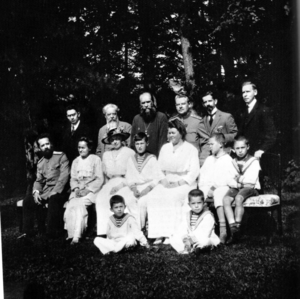
During World War I, Alexei spent a lot of time with his father at army headquarters in Mogilev. He saw military life and seemed to enjoy it. Alexei even became one of the first Boy Scouts in Russia.
In 1916, Alexei was given the title of Lance Corporal, which made him very proud. He became a favorite of the foreign military officers visiting Russia. He would often joke with them.
At Army Headquarters
When his father became the Commander-in-Chief of the Russian Army in 1915, Alexei joined him at Stavka (the army headquarters). Alexei loved military life and became very playful. His father wrote to his mother that Alexei would spray them with water at the fountain and laugh. Alexei even ate the soldiers' plain black bread, refusing his usual palace meals.
In December 1915, Rasputin was called to see Alexei. The 11-year-old boy had accidentally been thrown against a train window, and his nose started to bleed.
Imprisonment of the Royal Family

The imperial family was arrested after the February Revolution of 1917. This revolution led to Nicholas II giving up his throne. While held captive in Tobolsk, Alexei wrote in his diary that he was "bored." He prayed to God for "mercy." He was allowed to play with a doctor's son, Kolya, and a kitchen boy, Leonid Sednev.
As he got older, Alexei sometimes seemed to take risks. While in Siberia, he rode a sled down the stairs of the prison house. This caused a bad injury and severe bleeding in his groin. He was so ill that he couldn't be moved when his parents and older sister Maria were taken to Yekaterinburg in April 1918. However, his parents' diaries say the bleeding was caused by a coughing fit. Alexei and his three remaining sisters joined the rest of the family weeks later. For the last weeks of his life, he needed a wheelchair.
Alexei's Death

Alexei was murdered on July 17, 1918, when he was 13 years old. He was killed in the cellar of the Ipatiev House in Yekaterinburg. The killings were carried out by the Bolshevik secret police.
For many years, people believed that some members of the family might have survived. Several people even claimed to be Alexei. However, scientists said it was very unlikely he escaped because of his severe hemophilia.
Discovery and Identification of Remains
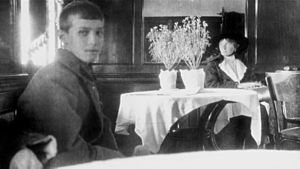
On August 23, 2007, Russian archaeologists found two burned, partial skeletons near Yekaterinburg. They matched the description from the memoirs of Yakov Yurovsky, who led the execution. The bones were from a boy aged 12 to 15 and a young woman aged 15 to 19. Alexei was almost 14 when he died. His sister Maria was 19, and Anastasia was 17.
Along with the bones, archaeologists found pieces of a container of sulfuric acid, nails, metal strips, and bullets. They also found striped cloth that looked like Alexei's blue-and-white striped undershirt.
On April 30, 2008, Russian scientists announced that DNA testing proved the remains belonged to Tsarevich Alexei and Grand Duchess Maria. Further tests by other laboratories confirmed this. In March 2009, the results were published, confirming that the two bodies found in 2007 were indeed Alexei and Grand Duchess Maria.
Sainthood
| Saint Alexei Romanov | |
|---|---|
| Saint, Tsesarevich and Passion bearer | |
| Honored in | Russian Orthodox Church |
| Canonized | 1981 and 2000 by Russian Orthodox Church Abroad and the Russian Orthodox Church |
| Major shrine | Church on Blood, Yekaterinburg, Russia |
| Feast | 17 July |
The Romanov family was recognized as holy martyrs in 1981 by the Russian Orthodox Church Outside Russia. This church was formed by Russians who left the country after the revolution. After the Soviet Union ended, the Russian government agreed to bury the bodies of Tsar Nicholas II, Tsarina Alexandra, and three of their daughters. They were buried at St. Peter and Paul Cathedral in St. Petersburg on July 17, 1998, exactly 80 years after their deaths. In 2000, Alexei and his family were officially made saints by the Russian Orthodox Church.
As of 2015, Alexei's and Maria's remains had not yet been buried with the rest of their family. The Russian Orthodox Church asked for more DNA testing to be absolutely sure of their identities.
Images for kids
-
The Romanovs with His Majesty's Own Cossack Escort during World War I. From left to right, Grand Duchess Anastasia, Grand Duchess Olga, Tsar Nicholas II, Tsesarevich Alexei, Grand Duchess Tatiana, and Grand Duchess Maria, with Kuban Cossacks
-
Nicholas II, Alexei, Tatiana and Nikita
-
Tsesarevich Alexei Island southeast of Emperor Nicholas II Land in a 1915 map of the Russian Empire.
See also
 In Spanish: Alekséi Nikoláyevich Románov para niños
In Spanish: Alekséi Nikoláyevich Románov para niños



